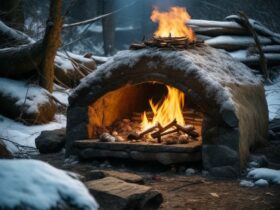In the unpredictable wilderness or during emergency situations, a well-prepared survival food kit becomes a literal lifeline. The science of survival extends beyond shelter and navigation; it includes understanding the crucial role of nutrition in maintaining physical strength and mental resilience. This article navigates the realm of survival nutrition, guiding you through the process of packing the perfect survival food kit, ensuring that you have the fuel needed to face the challenges of the unknown.

The Caloric Calculus: Understanding Nutritional Needs
The foundation of a perfect survival food kit lies in a comprehensive understanding of nutritional needs. Calories, the units of energy derived from food, are the primary consideration. Survival situations demand an increase in caloric intake due to heightened physical exertion and stress. Understanding one’s baseline caloric requirements and factoring in the additional demands of survival activities is the first step in crafting a well-balanced kit.
Proteins, fats, and carbohydrates constitute the macronutrients essential for sustained energy. Proteins aid in muscle repair and maintenance, fats provide concentrated energy, and carbohydrates offer quick fuel for immediate use. Striking the right balance among these macronutrients ensures that the body receives the necessary nutrients for optimal function during survival scenarios.
Longevity in a Package: Choosing Shelf-Stable Foods
The ideal survival food kit prioritizes shelf-stable items with a long storage life, ensuring that they remain edible over an extended period. Dehydrated or freeze-dried foods are excellent choices, as they retain their nutritional value while significantly reducing weight and volume. Meals ready-to-eat (MREs) offer a convenient option with pre-packaged, calorically dense meals designed for easy consumption.
Canned goods, if properly sealed, also provide a shelf-stable option, though they tend to be heavier and bulkier. Non-perishable items such as nuts, seeds, dried fruits, and jerky contribute to the caloric density of the kit while offering variety in taste and texture. By choosing foods that can withstand the test of time without compromising nutritional content, you ensure the longevity and effectiveness of your survival food kit.
The Hydration Equation: Water and Electrolytes
While the focus is often on solid sustenance, hydration is equally critical in a survival food kit. Water, a basic necessity, should be prioritized both in terms of quantity and purification methods. Including portable water filters, purification tablets, or lightweight purification systems ensures a constant supply of safe drinking water.
Electrolytes, minerals like sodium, potassium, and magnesium, are essential for maintaining proper bodily functions. In extreme situations, the loss of electrolytes through sweat and exertion can lead to dehydration and physical decline. Including electrolyte supplements or powdered drink mixes in the survival food kit helps replenish these crucial minerals, supporting overall hydration and well-being.
Customization and Convenience: Tailoring Your Kit to Individual Needs
The perfect survival food kit is a personalized creation that considers individual preferences, dietary restrictions, and specific needs. Customization allows for a more enjoyable and sustainable eating experience during survival scenarios. Individuals with allergies or dietary restrictions should be especially mindful of their choices, opting for alternatives that align with their nutritional needs.
Including comfort foods, such as chocolate or energy bars with familiar flavors, can provide a psychological boost in challenging situations. Convenience also plays a role in the selection process, with easy-to-open packaging and minimal preparation requirements being key considerations. A well-designed survival food kit not only meets nutritional needs but also aligns with individual preferences, promoting overall satisfaction and mental well-being.
Conclusion
The caloric compass of a survival food kit guides individuals through the complexities of nutritional needs in extreme situations. Beyond mere sustenance, the perfect survival food kit becomes a strategic asset, ensuring that the body and mind are equipped to face the challenges of the unknown. By understanding the caloric calculus, choosing shelf-stable foods, prioritizing hydration, and customizing the kit to individual needs, you create a comprehensive and effective tool for survival.
In the realm of survival, nutrition is not just about staying fed; it is about maintaining physical strength, mental resilience, and overall well-being. As you embark on your next adventure or prepare for unforeseen circumstances, let the calorie compass be your guide, ensuring that your survival food kit becomes a source of sustenance, strength, and confidence in the face of the unexpected.





Leave a Reply